The railroad industry was very volatile. The truth is, too many of them were built, and this gave some people, most famously robber baron Jay Gould, an opportunity to make a living off of buying up small railroad companies, selling off their assets and then shutting them down. Railroads often changed names as they were bought and sold by numerous companies. This is why we refer to the same railroads with different names.
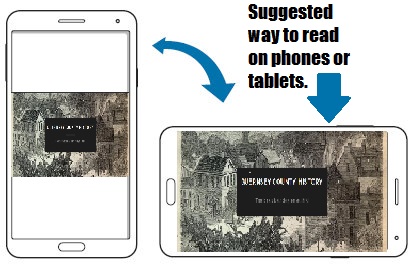
Let’s imagine a day without the interstate highway. Let’s imagine a day when Southgate Parkway is nothing more than wilderness with deer’s running about the weeds in open fields. Imagine when Wheeling Avenue is a dirt road; that get’s trampled on by horses as they carry behind them carriages of people. The sound of a freight train chugging and chooing as it carries on it a very important person.

Teddy Roosevelt circa 1902
The year is 1912 and people have started to gather near the old covered bridge at Union Station (more widely known today as Ameridial)—the old log bridge would not be replaced by a viaduct for another 12 years—people are awaiting the arrival of the beloved former President turned candidate Teddy Roosevelt. Excitement and anticipation fills the air, people are telling the terrible story of Mr. Roosevelt’s first appearance in Cambridge a decade earlier. “His face was terribly bruised” says one bystander. Another person agrees, “He was hardly recognizable.” Mr. Roosevelt appeared in Cambridge in 1902 shortly after an accident in New England. Another eyewitness complains of the speech, “One would think with the President coming to town, preparations would have been made better so that we could hear him speak.” On the first visit, steam engines at the station were so loud the President’s words were incomprehensible. It was so bad, the President become frustrated and left Guernsey County early to get ahead of schedule.
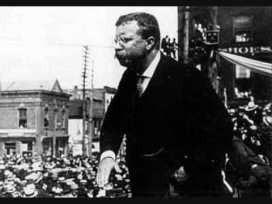
Teddy Roosevelt 1912 Campaign
But here we are now ten years later, people are awaiting the arrival of the most famous man to set foot in Cambridge, again. They’re pouring out of the Depot Hotel and bar, many more coming down Wheeling Avenue all of them traveling over to the station to catch a glance at the head of the newly formed Bull Moose Party. It’s said some 6,000 people awaited his arrival and in the afternoon on May 20th, 1912 he appeared. This time the counties officials had done their due diligence by setting up an event at the courthouse where the former President could give a speech. Some 2,000 more people joined at the courthouse, for a total of 8,000 people gathering to hear Teddy. He started his speech with “Splendid, looks like victory!” he went on to make a persuasive argument to the counties republicans, convincing many of them—but not enough of them—to give him his vote over the current President and his protégé, William H. Taft. When the speech was finished Teddy went back down to the Union Station, hopped back on his train and continued north on the Pennsylvania Railroad.
The Central Ohio Railroad/The Baltimore & Ohio (B&O) Railroad
I tell you this story because I think it’s reflective of the history of the railroads and the train stations of our area. Rather than bore you with a bunch of historical facts I would much rather challenge your imagination. There were two important railroads that come through Cambridge of which all others branched off of at later dates. First the Central Ohio Railroad Company/B&O Railroad that went east and west, and secondly the Cleveland and Marietta Railroad/the Pennsylvania Railroad that went north and South. Both have interesting histories but in order to tell you that history, I need you to hop into our time machine once again and travel back another 60 years from 1912 to 1847, on this journey you’ll need to erase the Union Station and the Depot Hotel, you’ll have to erase many advancements and building brought on by the industrial revolution, and you have to imagine Cambridge, as not much more than a large collection of wood cabins, along with some taverns and civic buildings. On February 8th 1847, a special act by the Ohio Congress, gave authority to build a railroad from the Ohio River to Columbus, Ohio. The path was outlined roughly by the state and included naming Cambridge at the center of the project.
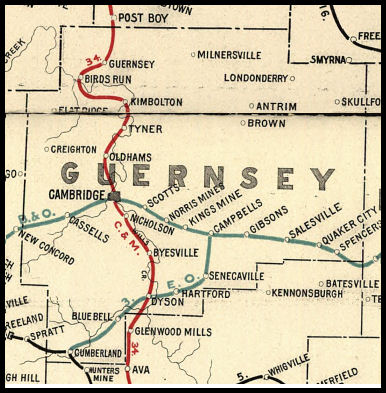
The B&O Entered Guernsey County Near Quaker City and Leaves in New Concord
At this time the industrial revolution is in mid swing. Steam boats had made it quicker to travel across large bodies of water. Ports in New York City, collected products sent them up the Hudson Bay through the Erie Canal and onto the Great Lakes where they could be distributed to midwest urban centers like Buffalo, Cleveland, and Detroit. In response to the steam boat technology, cities that weren’t fortunate enough to have a body of water taking them into the west were getting crushed in the market and they decided to start investing in technology that would give them steam power over land. Thus the railroad was born. Initially the project in Ohio was headed by The Central Ohio Railroad Company. They were the ones that sold stock to have the railroad built and subsequently the route it would take. A short battle ensued in Guernsey of where the railroad would enter the County, however, a prominent Quaker from Millwood (Quaker City) named John Hall was able to make this battle a somewhat short one by pledging $23,000 to the project, $10,000 from his own pocket. So it was decided the train would enter the county at Quaker City, go through Cambridge, include a tunnel and exit in New Concord heading towards Zanesville. Though the project set out in 1847, the first passenger train to arrive in Cambridge was not until April 27th, 1854. The significance of the event can be found in the books History of Guernsey County by C.P.B. Sarchet, Stories of Guernsey County by William G. Wolfe, and the Guernsey Times: a predecessor of the Daily Jeffersonian. Most people were very excited to ride a train, others swore they would never ride such a dangerous monstrosity.
Sarchet says in his book:
“The arrival of the first regular passenger train over the road now known as the Baltimore & Ohio, from Columbus was on April 27th, 1854. It consisted of six coaches and it was welcomed right royally. The march from the station to the public square was a long, enthusiastic one, was under marshalship of Loll Lordon I. of land and an address was made by Hon. Nathan Evans. Military Companies from Columbus and Zanesville were present.”
Wolfe includes this excerpt from the Guernsey Times (on mobile devices use index finger and thumb to zoom):


Photo Credit: Daniel Adair
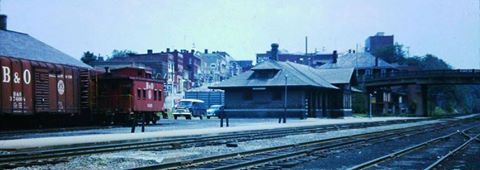
Photo Credit: Tom Severns
The Cleveland and Marietta Railroad/Pennsylvania Railroad
I’m going to have to ask you to jump in that time machine once again. We have to take a ride pass the bloody Civil War, and pass Lincolns assassination to the era known as “Reconstruction.” Shortly after the war a wave of prosperity passed through the nation. Interest and enthusiasm rose in Guernsey County when a survey was taken for a railroad going north and south from Marietta to Cleveland by a former General named A.J. Warner. There was already a railroad from Marietta to Caldwell so it seemed and was a logical idea to continue that route up through Guernsey County. Once again the county had to raise money through selling stock. Meetings were scheduled at the courthouse to explain the potential investment. It’s said John H. Sarchet had a song he would sing when the town’s excitement turned to skepticism. The song was titled, “Buy Another Share or Two,” and he went about the old courthouse singing this to get people interested again. Just before the deadline the quota was met to build to the railroad.
Soon after the money was raised, a feud arose between the leaders of Cambridge and the leaders of Marietta. Leaders from both the communities understood the economical significance of the location of the machine shops. The machine shops meant jobs, and for local economies jobs meant money, a higher standard of living, and further community development. After the railroad was built, the machine shops would mean a servicing center in Cambridge for trains. Cambridge leaders took the initiative and called for a special election. The election was to entice voters into paying for a road from the proposed machine shops to the building sites of the railroad. The deal was that the road would be leased to the railroad company for free until the project was finished and begun seeing returns. This was ideal for the railroad company and so the shops were built in Cambridge.
Marietta officials were furious. They opened a case against Cambridge, claiming the special election was against the law. The case went all the way up to the Supreme Court of Ohio, they ruled in Marietta’s favor claiming the special election unconstitutional. However, since the shops were already built and the project already underway, Cambridge got to keep the machine shops and no other damages were awarded. Cambridge leaders must have toasted to this win in jest while the citizens did the same at the taverns across town. We have to be proud of not just the leaders who made this happen, but our ancestors who without the vote would not have been possible. And so the Marietta and Cleveland Railroad was built entering the county near Pleasant City and leaving the county pass Liberty City (later named Kimbolton.) In 1873 it was finished and celebrations again occurred as two engines were placed on the tracks. One named “Cambridge” and the other named “Liberty” commemorating the town’s most prominent in having the railroad built.
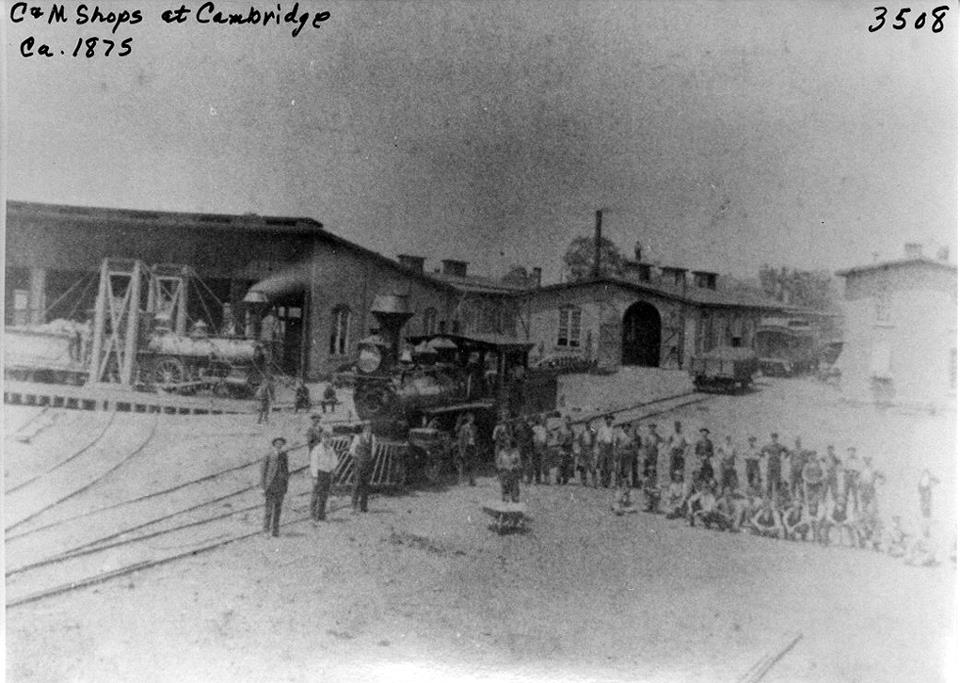
There Was a Political Battle Between Cambridge and Marietta Leaders Over Where These Shops Would Be Located: Cambridge Won the Battle
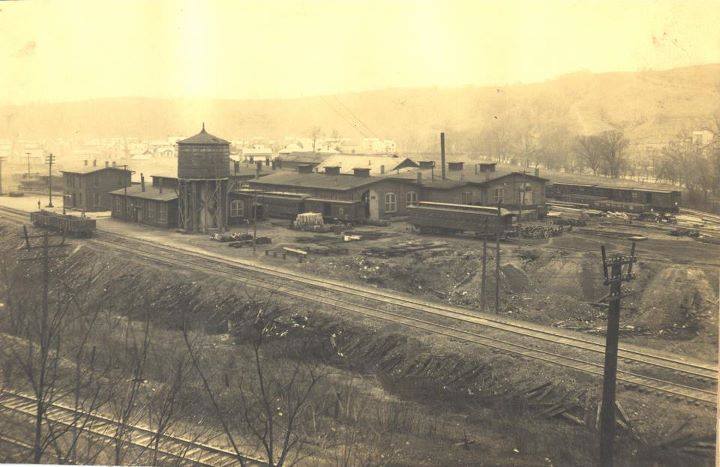
Cleveland & Marietta Shops

Trains being serviced at C&M Shops

C&M Group Picture

Pennsylvania Railroad
The Economic Significance of the Railroads
As I mentioned in the beginning of this history, the Central Ohio Railroad/the B&O Railroad and the C&M Railroad/Pennsylvania Railroad laid the foundation for smaller tracks to branch off of to our county’s smaller towns. They weren’t the only tracks laid in the county, they were just the first and all other tracks led back to them. Before the railroads came to Guernsey County our towns weren’t much more then small groups of cabins connected by paths through the wilderness. After the railroads were built, our towns become markets for industry. Byesville owes it’s existence to the coal industry, which depended on the railroad to export its product to bigger American metro’s like Cleveland, Columbus and Cincinnati. The buildings that make up Byesville are there because there was a coal industry to attract workers, which ultimately made a village that needed stores, schools, and churches. While Cambridge was luckier in that it had a more developed community before, it wasn’t until after the railroads were put in that Cambridge generated enough wealth to become a classic Victorian era city. Company owners were wealthy enough to build “Boardwalk and Park Place” like mansions down 7th Street. From 1890 to 1910 Cambridge’s population increased by 177%, an unprecedented number in its history. There were more people living in the Cambridge City limits in 1910 then there were in 2010. Likewise there were more people living in Guernsey County as a whole in 1910 then what live here today.

Byesville Main Street
The Train Station
Our ancestors failed to see the significance the Depot Hotel had to our history. Before it was a hotel and a bar called the “Bloody Bucket” or “Bucket of Blood” it was our area’s first train station. Think about how cool it would be to travel back to the 1800’s, where you would get off a train at the Depot, get a room for the night, and travel down stairs to the bar for a drink and bite to eat. The Depot fell into bad shape, gained a terrible reputation, and was torn down. Before that, it gained so much traffic as a train station a new station had to be built to take on that traffic. We’re lucky that station and its history are still available to us all to see with our eyes. However, I’d be lying if I said I wasn’t concerned. For years this building held the telemarketing company Ameridial. It’s now sitting doing nothing and it’s my fear eventually this building will see the same future as the Depot. It’s my fear it will be seen as a public or commercial scar instead of a gem and it will be sold off to a buyer that intends to tear it down and replace it with something new. This would be a tragic situation for our area and future generations. I don’t think I have ever seen a building more fit for a museum then this one. It is my hope that somehow people will begin to see the value of this property and the history behind it and something can be done to save it from the same fate as the “Bloody Bucket.”
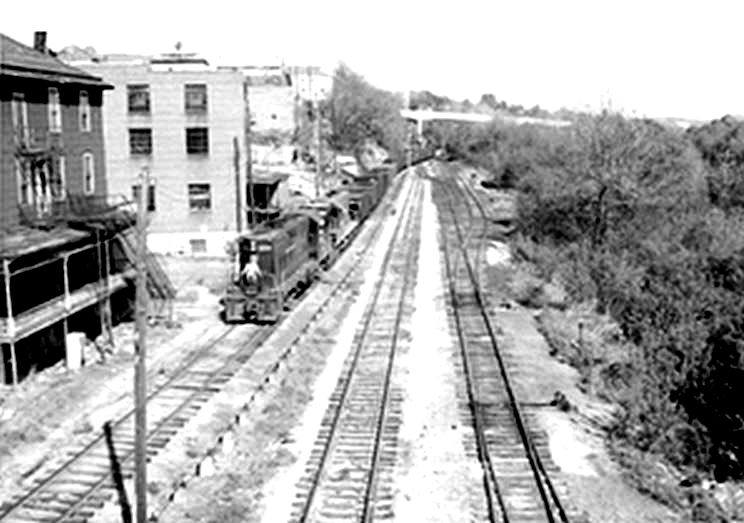
Think about how cool it would be to travel back to the 1800’s, where you would get off a train at the Depot, get a room for the night, and travel down stairs to the bar for a drink and bite to eat.
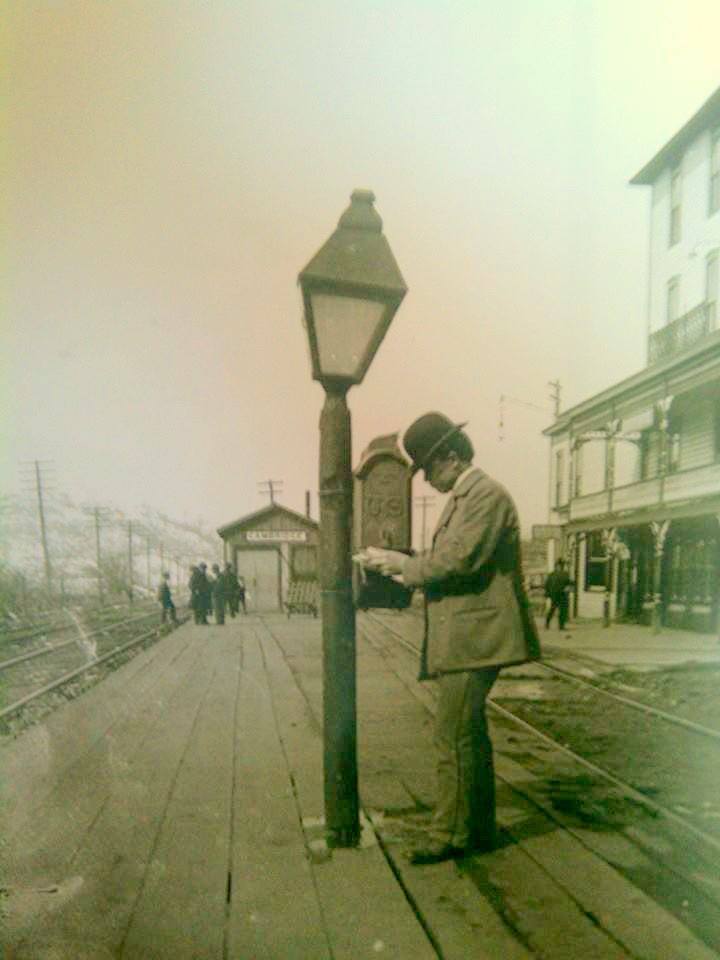
“The Depot” When it Operated as a Train Station and a Hotel



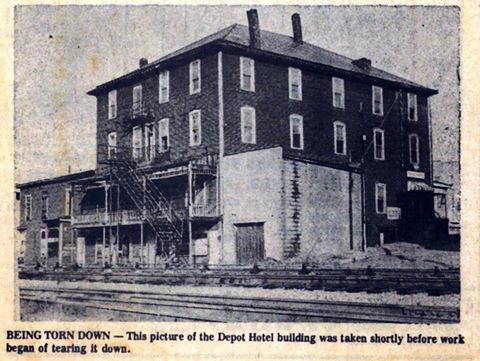
For well over a century, from 1850 to 1961, the railroads and the local train station symbolized a connection to a much larger world. It was real proof to the citizens of this area; proof that they were a part of a society greater than their eyes could see from day to day. Real living and breathing Presidents came and gave speeches at the station. Many events started with people waiting for trains to come in with important people on them and followed with a trip to the town square. When the nation called and it was time to go to war, throughout many generations our citizens didn’t sit at the train station awaiting an important person; they were taking an important person to the station to send them off to defend America against the evils filling our world. When the war was over, once again the community paraded to the bottom of Wheeling Avenue to celebrate the return of their children. Some sat home to mourn a loss that would not show up there. In any case, the train station that sits at the bottom Wheeling Avenue was not only the heart of the city of Cambridge; it was the heart and soul of the entire county for many, many, generations and it saddens me to drive by today and see an empty post-industrial building with a for sale sign instead of something reflecting what it truly symbolizes.

The Union Train Station



This Appears to be Soldiers Leaving or Coming Home From War. Photo Credit: Jim Fite
I did my best to photo credit the correct people. If you feel you should be credited please feel free to contact me via Facebook.


